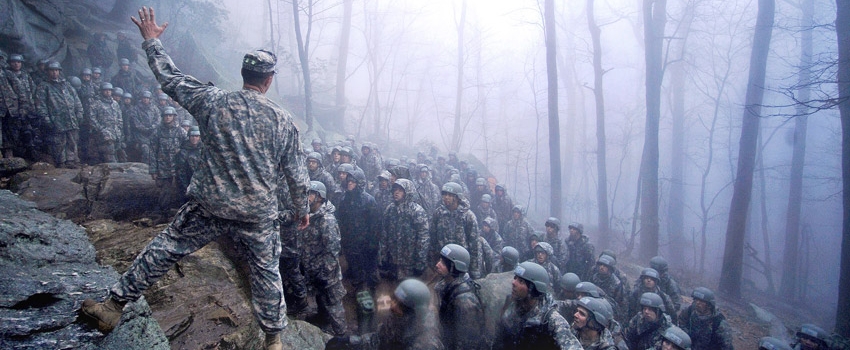
In the military, there is a technique for estimating distance. It's known as counting "flash-to-bang" time. It works like this:
An explosion takes place and immediately you see the "flash" of the explosion.
Start your timer...
Sometime later (depending on your distance from the explosion) you hear the "bang."
Stop your timer!
If you were to record the time between seeing the flash and hearing the bang, you can effectively estimate your distance from the explosion. To do this, all you need to know is the constant involved.
In this case it's the speed of sound. If you were paying attention in 5th grade science class, (or you quickly reference Wikipedia), you might recall that the speed of sound is 343.2 metres per second. This is 1,236 kilometres per hour (768 mph), or about one kilometer in three seconds or approximately one mile in five seconds.
The best example I can think of, that occurs in nature, is thunder and lightning. We see the flash of lightning in the sky, but only hear the bang of thunder some time later. Based on what you know now, a lighting flash followed less than 5 seconds later by the bang of thunder lets you know that the lightning struck less than 1 mile from your position.
That seems like a long explanation for a simple concept, but I write this blog in an effort to keep my readers interested. I also write it in hopes of educating them. Having laid that ground work, here's what this series is all about.
Inside The Numbers
PTSD studies, as I eluded to in our last blog, are coming from the front lines now. The more I read them, the more I am beginning to detect a constant, so to speak. Like counting flash-to-bang time, you can expect the "ugly side" of PTSD to fully manifest itself between 3 to 6 months AFTER our warriors return from the combat box. Granted, not all reactions are the same and there have been reported cases where the bulk of the disease manifests overnight or grows to become noticeable after years of normal behavior. These cases happen, but writing today, I am referring to the largest part of the affected population. This is my way of trying to reach the greatest number of warriors affected, so I speak to these general terms.
The study I shared with you last week is a type of study known as a longitudinalstudy, meaning that a study makes repeated observations of the same items over long periods of time. Last week we saw a doubling of PTSD being reported between preparation to return and 1 year after the return home from combat. This week, I have another longitudinal study:
Published in the Journal of The American Medical Association in 2007, the lead investigator, Charles Hoge, M.D. and colleagues observed the following: "A population-based cohort of 88,235 US soldiers returning from Iraq completed both a Post-Deployment Health Assessment (PDHA) and a Post-Deployment Health Re- Assessment (PDHRA) with a median of 6 months between the 2 assessments. Soldiers reported more mental health concerns and were referred at significantly higher rates from the PDHRA than from the PDHA.
Based on the combined screening, clinicians identified 20.3% of active and 42.4% of reserve component soldiers as requiring mental health treatment. Concerns about interpersonal conflict increased 4-fold. Soldiers frequently reported alcohol concerns, yet very few were referred to alcohol treatment. Most soldiers who used mental health services had not been referred, even though the majority accessed care within 30 days following the screening."
Final Analysis
Although soldiers were much more likely to report PTSD symptoms on the PDHRA than on the PDHA, 49% to 59% of those who had PTSD symptoms identified on the PDHA improved by the time they took the PDHRA. The large clinical burden recently reported among veterans presenting to Veterans Affairs facilities seems to exist within months of returning home, highlighting the need to enhance military mental health care during this period.
These studies coming forward are giving us insight as to when the bulk of the disorder begins to emerge. Additionally, they are showing us that earlier detection and treatment lead to better outcomes. With this in mind, I have only this to
say:
Commanders, have your troops re-assessed. Loved ones, be on the look out for increased agitation and substance/alcohol use. Warriors, look to your left and right and urge your buddies to just talk to someone. You have too much at stake to ignore this beast. Like the old saying goes, "It takes years to build a reputation and only minutes to ruin it."
PTSD is that kind of beast!
Take Away
Like a flash of lightning, the terrors of combat strike without warning. Warriors in harm's way react to the situation based on their training and the enemy they are confronted with. There is nothing we can do about the flash...it is a memory now. What I am urging you to do, is to start counting, as the data is beginning to uncover when we can expect the "bang" to truly manifest. On a larger scale, I would like to submit this insight: One day soon, all our warriors will return home. Based on what you know now, do you think we are ready as a nation to meet the challenge in front of us?
Get ready to start your timer...
Warrior, out!
